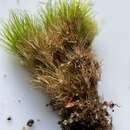Associations
provided by BioImages, the virtual fieldguide, UK
Plant / grows among
solitary or gregarious apothecium of Lamprospora campylopodis grows among Campylopus fragilis
Comments
provided by eFloras
Campylopus fragilis has only been found in a few localities in British Columbia and a single locality in Arkansas. It has been reported from southeastern North America based on the presence of boomerang-shaped brood leaves at the stem tips, however, these records belong to C. surinamensis with similar brood leaves. Campylopus surinamensis differs by rectangular and nonquadrate distal laminal cells, a sharply toothed, denticulate, excurrent costa and small adaxial hyalocysts. Brood leaves are produced especially “under stress” in unfavorable conditions, especially on small, depauperate plants.
- license
- cc-by-nc-sa-3.0
- copyright
- Missouri Botanical Garden, 4344 Shaw Boulevard, St. Louis, MO, 63110 USA
Description
provided by eFloras
Plants 0.5-2 cm, yellowish green, in tufts, very densely foliate, often ending in a penicillate comal tuft, whitish tomentose. Leaves 4-5 mm, ovate-lanceolate, widest below the middle and contracted at base, narrowed into a more or less long straight, concolorous subula; alar cells hardly developed; basal laminal cells thin-walled and hyaline, very distinctly differentiated from the distal thick-walled and quadrate laminal cells; costa filling 1/2-2/3 of leaf width, shortly excurrent, slightly serrate at tip, in transverse section showing very wide adaxial hyalocysts (easily recognizable in surface view of the costa), filling half of the width of the costa, and abaxial substereids, slightly abaxially ridged. Specialized asexual reproduction by small, boomerang-shaped leaves produced in the axils of the distal leaves. Sporophytes not known in North America.
- license
- cc-by-nc-sa-3.0
- copyright
- Missouri Botanical Garden, 4344 Shaw Boulevard, St. Louis, MO, 63110 USA
Synonym
provided by eFloras
Dicranum fragile Bridel, J. Bot. (Schrader) 1800: 296. 1801
- license
- cc-by-nc-sa-3.0
- copyright
- Missouri Botanical Garden, 4344 Shaw Boulevard, St. Louis, MO, 63110 USA
Comprehensive Description
provided by North American Flora
Campylopus fragilis (Dicks.) B.S.G. Bryol. Eur. (41:)
Campylopus 4. 1847.
Bryum fragile Dicks. PL Crypt. Brit. 3: 5. 1793.
Plants in compact, pale, glossy-green tufts, up to 4 cm. high; stems tomentose below, branching above, more or less whitish within from the pale , bases of the leaves: leaves about 5 mm. long, densely imbricate, rather uniformly placed and more or less erect-spreading on all sides, from an oblong base, narrowly lanceolate, somewhat serrulate in the upper third with the costa shortly excurrent; costa extending about one half across the leaf-base, somewhat ribbed on the back above, in cross-section below showing a row of large cells on the ventral side extending about one half through and a stereid-band on the dorsal side with a row of more or less differentiated cells on either side of the band ; alar cells wanting, the lower cells toward the costa thin-walled, lax, up to 20 p wide by 80 y, long, narrower toward the margin, scarcely forming a distinct border, hyaline or very pale about one fourth up the leaf to the rather abruptly narrowed part of ,the blade where the cells become short and more or less obliquely elongate or rhomboidal with somewhat thickened walls, the cells in the very narrow blade above mostly short, more or less rhomboidal ; perichaetial leaves sheathing about one half up, gradually narrowed to a subulate point: seta sinuous above when dry, 5-8 mm. long: capsule regular, elliptic, ribbed; lid about one half as long as the capsule: calyptra ciliate at the base: spores 14-16 fi in diameter, finely papillose.
Type locality: Great Britain. t . .
^Distribution: Florida and Jamaica (sterile specimens); also in Europe, Asia, and Ainca. .
- bibliographic citation
- Robert Statham Williams. 1913. (BRYALES); DICRANACEAE, LEUCOBRYACEAE. North American flora. vol 15(2). New York Botanical Garden, New York, NY

